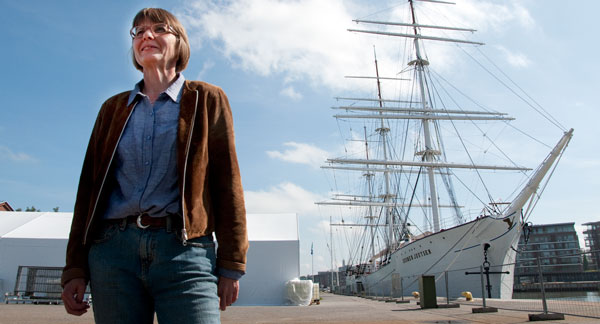Johanna Mattila. Photo: Nicklas Hägen.
Sulphur emissions, erosion, oil accidents, chemical leaks and invasions of foreign species into new ecosystems – there are numerous examples of the environmental problems caused by shipping.
Nicklas Hägen
In the 1980:s acidification was a big problem and it was caused by, among other things, industrial emissions, road and sea traffic, and heating systems. Considerable developments have taken place since then; we use unleaded fuel and factories filter sulphur and oxides out of their waste emissions.
However, developments in the shipping industry have stagnated in this respect and it has, for a long time, been the key agent responsible for the highest levels of sulphur emissions into the Baltic Sea area. According to Johanna Mattila, head of the Åbo Akademi University Biological Station in Husö on the Åland Islands, sulphate emissions into the air result in acid rain, which contributes to corrosion and has serious health consequences.
“A Danish study has calculated that the emissions from ships have annually caused as many as 50,000 premature deaths in Europe.”
Sulphur causes acidification when it bonds with water and oxygen molecules, both on land and in the sea, and most damage occurs in the archipelago areas.
The new Sulphur Directive has sparked protests, but according to Mattila, the application of stricter environmental restrictions tends, in the long run, to be a step forward for the industry. For example, the wood industry realised that they could utilise materials that had previously been flushed into the sea for making more by-products, and the car industry has developed in only a positive direction since it predicted its own death in response to the introduction of the requirement for unleaded petrol.
“Stricter environmental requirements have often ended in making savings, once the technology has caught up. The problem is that so many of the ships currently in use are still in good sailing condition. Complying with the directive is not expensive when new ships are built and designed in compliance with the required technology, but rebuilding an old vessel entails a large one-off cost and the result is not as efficient,” says Mattila.
The alternative is to convert to fuels which contain less sulphur, but these consist of higher grade oil and are thus more expensive. Another future possibility could be to stop using oil entirely and change to liquid natural gas, LNG, instead. However, at the moment we lack an infrastructure which would enable a large-scale transition to gas-driven ships.
Slow improvement
Many European ports are located at river mouths which frequently need to be dredged as new land mass gathers on the seabed. This spreads concentrations of nutrients (such as phosphorus and nitrogen) and other harmful substances; to some extent this is because the area dredged is in water and cannot be closed off, and partly because the sediment removed has to be disposed of somewhere else.
For instance, when the Vuosaari Harbour in Helsinki, Finland, was built, large quantities of TBT (organotin compounds) and other poisons were found; they had gathered at the bottom of the sea when hulls which had been treated with bottom paint had been sandblasted.
Bottom paint residue is very harmful to fish and bottom feeders; the paint is actually used to prevent various organisms from fastening onto the hull of a ship. It is not unusual that new species enter an area by travelling on the hulls of ships and in the ballast water.
“They alter the ecology, but it’s not always all that easy to determine whether a new species has a negative or positive impact on an area, or whether it is simply modifying it. There are, for example, mussels that can enter the cooling water pipes of nuclear plants and thus create a risk, and predator fleas that cause problems by fastening onto fishing nets. However, we haven’t in general had any very extensive problems in the Baltic Sea caused by new species,” Mattila says.
“Usually a new species initially grows quickly in numbers until the rest of the ecosystem catches up. A new balance is thus created, which might, however, also entail financial losses.”
Big ships also cause surges and currents which have the effect of washing the shores close to major fairways clean of fine particles and salts. This results in erosion and creates problems in, above all, archipelago areas which comprise many small islands.
“The surge tears particles from the sediment and the nutrients flow further out, collecting behind islands and forming bilge water. We get thread algae and generally bad conditions in these areas. Eventually this results in a lack of oxygen and the proliferation of rotting algae. The fish disappear and the area is washed clean of bottom feeders.”
Are we sacrificing certain aquatic areas for the benefit of traffic?
“Most fairways are old and even though the size of ships traversing them has grown, we simply continue to use them. Nobody has thought of the implications of this.”
“In some cases it’s good to keep to the established routes, since it means that new areas aren’t exploited. On the other hand, the old fairways can be too narrow for today’s ships, which leads to continued or increased erosion.”
How big an interest in environmental issues do the shipping companies display?
“There are strict rules and recommendations, and when the International Maritime Organization (IMO) decides something, it’s binding. But things progress slowly; a large majority of the member states must ratify a decision for it to enter into force. Various NGOs conduct important work in this respect.”
“Some form of obligation is always needed in order for a change to happen, either through new rules or in that the general opinion grows so strong that the shipping companies must yield. But once they have started implementing the new rules, they might even go further than the original requirements.”
Sulphur in acid rain
Oil contains 0.1–3 per cent sulphur. When products containing sulphur burn, the sulphur reacts with oxygen in the air and forms sulphur dioxide.
Combustion: S + O2 ? SO2
Oxidation: 2SO2 + O2 ? 2SO3
When sulphur dioxides react with water, the result is sulphuric acids, which fall to the ground as so-called acid rain. The acids accelerate corrosion and dissolve harmful metals that are poisonous for animals and hinder conifers from absorbing nutrition and water.
Acid sulphate soils are discussed on the following pages. In such soils sulphur is kept bound mainly as iron sulphides (FeS and FeS2) as long as the ground is covered by water. When the soil is drained and the iron sulphides come into contact with oxygen in the air, they are oxidised into iron hydroxides and sulphuric acid (H2SO4), which lowers the pH in the soil and dissolves metals.


